Choosing First Plane and Radio
Tom Hintz - 03/12/2104
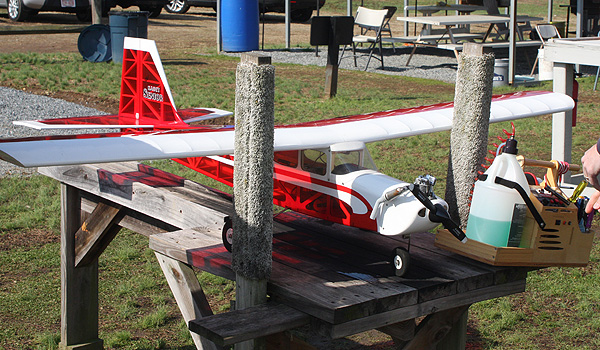
|
|
This is the SIG Kadet Senior, a very popular trainer that many experienced pilots still love to fly. Today there are far more choices when you work with an instructor and use modern equipment.
Click image to enlarge |
There are more legitimate choices today than ever
Plane Design
When I learned to fly Radio Control (RC) airplanes 30-some years ago beginners were usually limited to three or four channel high-wing planes with a glow engine. Those planes often had enough dihedral (V-shape of the wing) that combined with the high wing location the weight of the fuselage and its components worked as a pendulum to help keep the plane upright. Set up properly the new pilot could simply let go of the sticks and the plane would eventually find its way back to straight and level flight. The actual success of that pendulum-based recovery depended heavily on having enough altitude and the plane being in a "savable" attitude to start with. The reality was that student pilots tend to get planes in non-savable situations followed by frantic and wrong) stick inputs trying to save it. That made the preservation of the plane dependent on how quickly the instructor pilot could grab the radio and miss the ground.
Part of the reasoning back then for using these high-wing planes is that in addition to their inherent stability they flew relatively slowly so the new pilot had more time to learn how to manipulate the radio sticks to make the plane do what they wanted. Today there are dozens of low and mid-wing planes that have very similar slow speed flight characteristics to those old high-wing trainers yet they can also perform most aerobatics as the pilots skill grows. The adjustability of the modern radio allows us to make fully 3D capable planes docile and stable for a beginner who is teamed with an instructor.
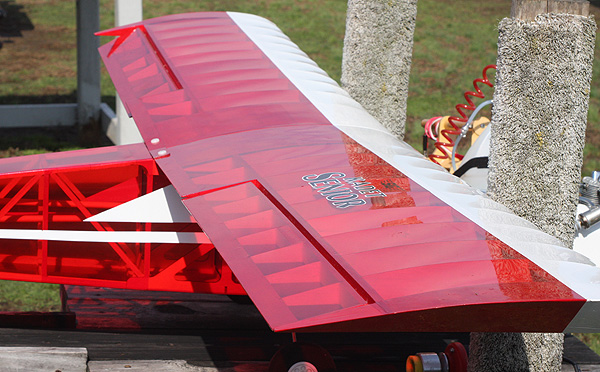
|
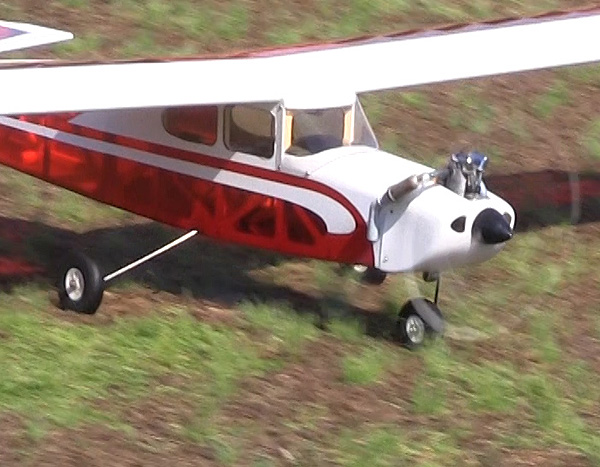
|
The Kadet has a large flat-bottomed wing (left) with dihedral that makes it fly slower and be more more forgiving. However we can use modern radio technology to tame down a more aerobatic plane for training also. Traditionally the "trike" landing gear (right) was preferred for training as it is a little easier to take off and land, plus has better ground handling than a tail dragger.
Click images to enlarge |
|
Today nearly all planes capable of being used as a trainer have aileron control in addition to the elevator and rudder. I think that is a good thing as the transition from three to four channels back when I started was often harder than learning on a four channel to start with. Modern radios and their wide-ranging capabilities make starting with a minimum of four channels a no-brainer.
There is also an expanded range of construction levels to choose from today. The full on, build-it-yourself balsa kits can still be found for those who enjoy the ground-up construction process. More recently ARF (almost ready to fly) planes have emerged. These planes are largely finished but need some final assembly and maybe radio gear installation. Then there is the PNP (plug and play) that also needs some assembly and you have to install your receiver. There are BNF (bind and fly) models that may need some minor assembly but already have a receiver and the remaining radio gear installed so all you have to do is bind your transmitter to it, check the radio settings to be sure the control surfaces move the right way to get ready to fly. Binding is teaching the radio to communicate with that receiver only.
Making these ARF-type planes more attractive is the use of ultra-precise laser cut parts and jig-based assembly. The result is a remarkably straight, strong and surprisingly light airframe that makes a plane fly better and more predictably. These planes are usually fully covered so many of the tasks that can compromise a planes performance are already done for the novice pilot. As an instructor "in the old days" I have made major "best guess" adjustments on planes to compensate for twisted wings and incorrect incidence (alignment of a wing or tail surface to the centerline of the plane) before it ever left the ground the first time. ARF planes also make it far more likely that the critical CG (center of gravity) will be correct with the battery installed or the fuel tank filled.
Plane Size
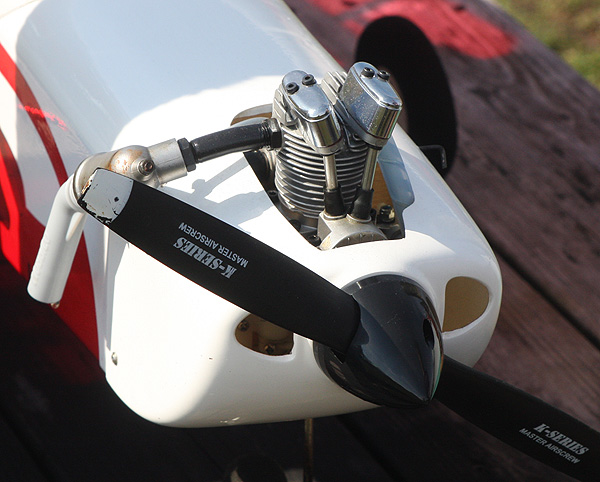
|

|
|
We used to be limited to gas or glow engines (left) like this 4-stroke. Those engines remain popular but now we have the option of battery powered aircraft (right) of all descriptions.
Click images to enlarge |
|
One of my pet peeves is when new pilots are sold small, inexpensive planes that "will almost fly themselves". While that may be possible in perfect conditions and you do not tell it to do something wrong the reality is that smaller planes are harder to handle, especially if there are even mild winds present. They also are difficult to see if they are not kept very close to the pilot, something very few beginner pilots do initially.
I would rather see a new pilot arrive with a plane with a wingspan of around 40-inches and over. It is hard to have too big of a plane but easy to get one that is too small. In a glow-powered plane I like to see 40 to 60 engine sizes because this kind of plane is large enough to handle some wind, can be seen more easily by new pilot eyes and fly smoother than the smaller versions. Electric-powered planes in the same size range (and larger) are very popular these days and are easier to operate because they lack the intricacies of tuning glow or gas engines.
Some plane manufacturers now have special receivers with built-in gyroscopic capabilities that help stabilize the plane. Some of these systems are effective enough to make a plane easier to handle in moderate wind conditions. However the idea that a total novice can go out by themselves and learn to fly a plane equipped with one of these stabilizing receivers and do it safely is more wishful thinking than fact. I have repeatedly seen these "crash proof" planes wind up in the trash barrel because a new pilot continued to make mistakes all the way to the ground. Flying RC planes is not a natural thing to do and must be learned. Trying to learn without the assistance of an experienced pilot is far more difficult and potentially dangerous. An out of control airplane of virtually any size can easily cause damage or injury, not to mention the ding to the pocketbook.
Radios
One of the biggest surprises for me when I re-entered RC flying was the capabilities of modern radios. First, the whole 2.4 GHz computerized, no frequency pin thing floored me. We used to have to clip a pin with the frequency number on the antenna before you could turn the radio on. If two radios with the same frequency were turned on any airplanes on that frequency in the air or being worked on were about to go out of control and crash. I had that happen a few times and saw it happen far too many other times back then.
The new computerized radios also have the ability to store many plane configurations in one radio dramatically reducing costs over not so long ago when you needed a transmitter/receiver system for each plane. You can use one of today's radios to fly a bunch of airplanes by simply selecting the plane (or helicopter) you want from the ones you have set up in that radio. All of the set up factors for that plane include servo reversing and trims are exclusive to that aircraft so when you select that model in the future all of those parameters are in force. That is simply remarkable.
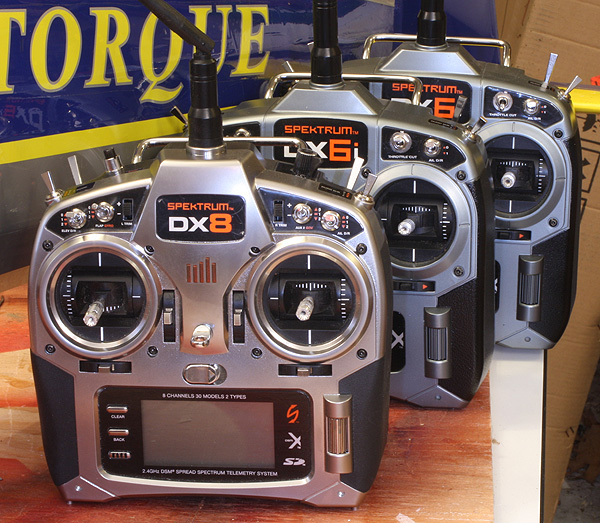
|
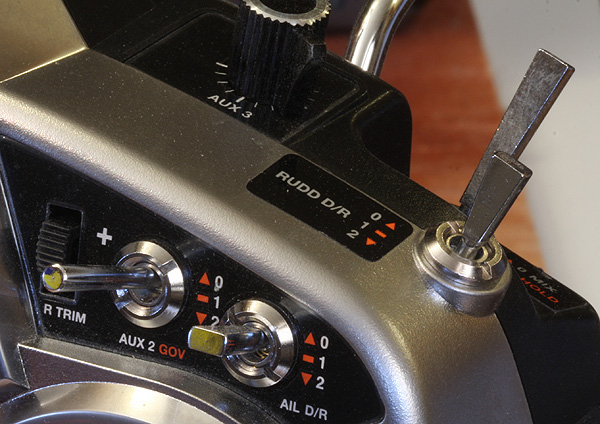
|
|
We used to need one full radio system for each airplane we flew. I have three (left) because one is used for training, one early model is used strictly on the simulator and the one at the front of this line flies all of my helicopters and airplanes with room for dozens more in its memory! Modern radios like this 8 channel have multiple-position dual rate switches (right) and other capabilities that let us dial down some aerobatic planes for training, then increase the planes performance as the pilots skills grow.
Click images to enlarge |
|
These new radios also sport huge adjustment capabilities that let you literally dial in the amount of performance you want from the plane. You can use the full control surface throw or as little as you like which is of particular interest when teaching new pilots. We can easily limit control surface travel and how quickly they respond to stick inputs right in the radio itself rather than having to work with servo and control horn lengths to change throws. Those same adjustments allow increasing control response as the student gains experience. That means student pilots can learn more with one plane and usually learn faster.
There is also the trainer system that allows connecting two radios so the instructor can hold a switch to give the student pilot full control of the plane. When the student gets the plane in trouble the instructor simply releases the switch to take control to right the plane before returning control to the student. Because the instructor can take over so quickly we can talk the student pilot through more maneuvers and let them get closer to the ground. Teaching landings was always very exciting before the trainer systems because once the student got low enough to land there was seldom enough time for the instructor to grab the radio away if they got in trouble. With the trainer system I tell the student to keep flying the plane no matter what. I can then take control in an instant if needed so I can let the student fly through the stages of landing with relative safety. Very often the student would be excited to learn that they had actually landed the plane themselves. With this system we can also get the student to practice landings over and over before letting them go solo without unduly endangering the plane. These trainer systems are directly responsible for more student pilots learning to fly more quickly with far fewer planes crashing in the process.
Radio Selection
Like anything else the price of radios varies according to their capabilities. More channels and features naturally cost more. The good news is that with modern radios being able to fly several different planes the new pilot can buy more radio to start with and save gobs of money in the long run.
I strongly recommend student pilots to buy as much radio as they can afford the first time around because I know what is going to happen in a few months (if that long) when they are flying solo and get the inevitable urge to move up in aircraft. Having an eight channel radio with all its capabilities may be overkill for most trainer-capable planes but once you learn the basics of flying those extra capabilities can let you get more from your first plane, temporarily tone down a more capable second plane and eliminate the need to buy a new radio for either. A good six channel radio will handle a normal plane including most with flaps and retracts but an eight channel gives you more options and features such as specific wing design configurations and being able to assign functions to the switches that make the most sense to you.
On my Spektrum DX8 a nice feature is three position dual rates. Plus, I can assign the dual rate function for the ailerons, elevator and rudder all on the rudder dual rate switch which is on the top right of the radio where it is very easy to get to while flying. I can set up three totally different dual rate configurations on that switch so I can dramatically alter how the plane responds as I need it during a flight. With some of the high performance 3D-capable planes this comes in handy and can also be very helpful for a newer pilot learning to handle these super aerobatic planes.
Video Tutor |
|
|
If you already belong to a club ask around for the instructor pilots and see what they have to say in regards to planes and radios. Watch what other people are flying, particularly other novice pilots. Some clubs may have a trainer plane and radio their instructors can use to get you started. But remember that learning to fly takes lots of practice so once you solo you need your own equipment. I prefer students to learn on their own plane so they get used to its characteristics which gives them more of a comfort zone when they start flying on their own.
Most of all don't be afraid to ask questions! RC folks are some of the friendliest, most helpful people on Earth because they enjoy flying with other people. Make use of all the experience walking around at your flying field and be ready to share your experience when the next new pilot shows up. You may not be a hot-shot pilot but having recently been through the learning process you can have valuable insight for those coming along behind you.